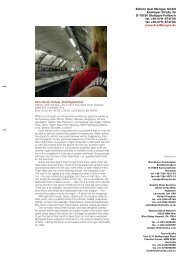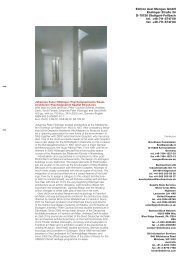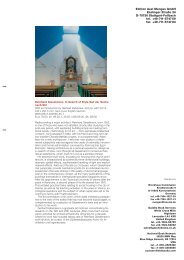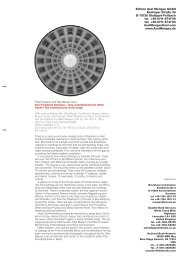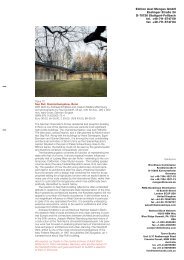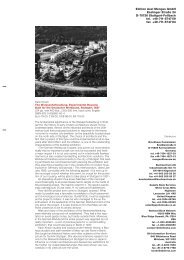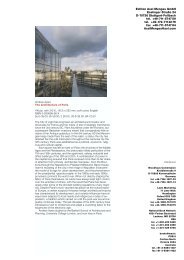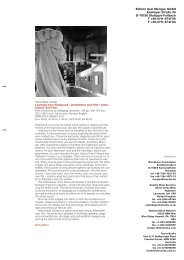Edition Axel Menges GmbH Esslinger Straße 24 D-70736 Stuttgart ...
Edition Axel Menges GmbH Esslinger Straße 24 D-70736 Stuttgart ...
Edition Axel Menges GmbH Esslinger Straße 24 D-70736 Stuttgart ...
Erfolgreiche ePaper selbst erstellen
Machen Sie aus Ihren PDF Publikationen ein blätterbares Flipbook mit unserer einzigartigen Google optimierten e-Paper Software.
Hans Dieter Schaal: Stage Architecture / Bühnenarchitektur<br />
With an introduction by Gottfried Knapp and an interview by Frank<br />
R. Werner. 2<strong>24</strong> pp. with ca. 250 ill., <strong>24</strong>2 x 297,5 mm, hard-cover,<br />
German / English<br />
ISBN 978-3-930698-86-8<br />
Euro 78.00, sfr 118.00, £ 49.00, US $ 78.00, $A 139.00<br />
»The moon has crashed to earth, or the ship in space has smashed<br />
to pieces against it. The fragments lie scattered. The ruins of Romanticism.<br />
The lovers have been struck dead by their own longing.<br />
The planets in the overarching night sky circle indifferently on.«<br />
(Hans Dieter Schaal, set for Act 3 of Tristan und Isolde by Richard<br />
Wagner, Staatsoper Hamburg, 1988.)<br />
Hans Dieter Schaal worked on opera with Ruth Berghaus for ten<br />
years, he also created unforgettable stage architecture for the operas<br />
of Heinz Werner Henze. Almost all the important European<br />
opera houses, for example those in Berlin, Brussels, <strong>Stuttgart</strong>, Paris,<br />
Vienna and Zurich, served as vehicles for his extraordinarily expressive<br />
artistic powers, which he used to captivate the public.<br />
As an architect he extended architectural thinking into the space<br />
occupied by free art. He has been a household word as a master<br />
of applied building art since his early books of signs, in which he<br />
plumbed the basic conditions and archetypes of architecture. Following<br />
his exhibition architecture, which decisively changed awareness<br />
of the dramatic revaluation of everyday and artistic objects,<br />
and which was published by <strong>Edition</strong> <strong>Axel</strong> <strong>Menges</strong> under the title<br />
In-Between, Exhibition Architecture, Schaal’s set designs are now<br />
being presented in a comprehensive form for the first time. Here<br />
too Schaal confronts the musical and scenic events with stereometric<br />
basic forms, primary colours and effective in-depth perspective.<br />
And so he brings, more clearly than the set designers, who<br />
are essentially painters, a third creative dimension on to the operatic<br />
or theatrical stage, which the scenic events echo particularly<br />
effectively, but which sometimes create considerable friction with<br />
them.<br />
Gottfried Knapp is responsible for architectural reporting as cultural<br />
editor of the Süddeutsche Zeitung in Munich. He has written<br />
on contemporary architecture and urban development in almost all<br />
the specialist publications in Germany. Frank R. Werner held the<br />
chair of building history and architectural theory at the Staatliche<br />
Akademie der Bildenden Künste <strong>Stuttgart</strong> from 1990 to 1993, since<br />
1993 he has been Director of the Institut für Architekturgeschichte<br />
und Architekturtheorie at the Bergische Universität in Wuppertal.<br />
He studied painting, architecture and architectural history at the<br />
Kunstakademie in Mainz, the Technische Hochschule in Hanover<br />
and <strong>Stuttgart</strong> University.<br />
<strong>Edition</strong> <strong>Axel</strong> <strong>Menges</strong> <strong>GmbH</strong><br />
<strong>Esslinger</strong> <strong>Straße</strong> <strong>24</strong><br />
D-<strong>70736</strong> <strong>Stuttgart</strong>-Fellbach<br />
T +49-0711-574759<br />
F +49-0711-574784<br />
Distributors<br />
Brockhaus Commission<br />
Kreidlerstraße 9<br />
D-70806 Kornwestheim<br />
Germany<br />
tel. +49-7154-1327-33<br />
fax +49-7154-1327-13<br />
menges@brocom.de<br />
Buchzentrum AG<br />
Industriestraße Ost 10<br />
CH-4614 Hägendorf<br />
tel. +41-062 209 26 26<br />
fax +41-062 209 26 27<br />
kundendienst@buchzentrum.ch<br />
Gazelle Book Services<br />
White Cross Mills<br />
Hightown<br />
Lancaster LA1 4XS<br />
United Kingdom<br />
tel. +44-15<strong>24</strong>-68765<br />
fax +44-15<strong>24</strong>-63232<br />
sales@gazellebooks.co.uk<br />
National Book Network<br />
15200 NBN Way<br />
Blue Ridge Summit, PA 17214<br />
USA<br />
tel. +1-800-4626420<br />
fax +1-800-3384550<br />
custserv@nbnbooks.com
2. Schaal, Stage, jacket 22.10.2002 21:52 Uhr Seite 1<br />
»Der Mond ist abgestürzt oder das Schiff im<br />
All daran zerschellt. Die Scherben liegen verstreut.<br />
Trümmerfeld der Romantik. Das Liebespaar<br />
ist von der eigenen Sehnsucht erschlagen<br />
worden. Die Planeten im überwölbenden Nachthimmel<br />
kreisen teilnahmslos weiter.« (Hans<br />
Dieter Schaal, 3. Bild zu Tristan und Isolde von<br />
Richard Wagner, Staatsoper Hamburg, 1988.)<br />
Zehn Jahre lang begleitete Hans Dieter Schaal<br />
die Opernarbeit von Ruth Berghaus. Auch für<br />
die Opern Heinz Werner Henzes schuf er unvergeßliche<br />
Bühnenarchitekturen. Fast alle wichtigen<br />
Opernhäuser Europas, wie die in Berlin,<br />
Brüssel, <strong>Stuttgart</strong>, Paris, Wien und Zürich, dienten<br />
ihm als Forum seiner außergewöhnlichen<br />
künstlerischen Ausdruckskraft, mit der er das<br />
Publikum in seinen Bann zu ziehen vermochte.<br />
Als Architekt hat er das architektonische<br />
Denken in den Raum der freien Künste hinein<br />
erweitert. Seit seinen frühen Zeichenbüchern,<br />
in denen er die Grundbedingungen und die Archetypen<br />
der Architektur ausgelotet hat, ist er<br />
als Meister der angewandten Baukunst ein Begriff.<br />
Nach seinen Ausstellungsarchitekturen, die<br />
das Bewußtsein für die dramaturgische Aufwertung<br />
von Alltags- und Kunstgegenständen in<br />
Ausstellungen entscheidend verändert haben<br />
und in der <strong>Edition</strong> <strong>Axel</strong> <strong>Menges</strong> unter dem Titel<br />
In-Between. Exhibition Architecture / Ausstellungsarchitektur<br />
veröffentlicht wurden, werden<br />
nun auch die Bühnenbilder Schaals erstmals in<br />
umfassender Weise vorgestellt. Auch hier sind<br />
es immer wieder stereometrische Grundformen,<br />
elementare Farben und perspektivisch effekvolle<br />
Tiefenräume, mit denen Schaal das musikalische<br />
und das szenische Geschehen konfrontiert.<br />
Er bringt also, deutlicher als die Bühnenbildner,<br />
die von der Malerei her kommen, eine<br />
dritte, eine bildnerische Dimension auf die<br />
Opern- oder Schauspielbühne, in der das szenische<br />
Geschehen besonders wirkungsvoll<br />
nachhallen, an der es sich aber auch heftig reiben<br />
kann.<br />
Gottfried Knapp ist als Kulturredakteur für<br />
die Architekturberichterstattung der Süddeutschen<br />
Zeitung verantwortlich. Er hat in fast allen<br />
Fachzeitschriften Deutschlands Kommentare<br />
zu aktuellen Architektur- und Städtebauthemen<br />
verfaßt. Frank R. Werner ist Direktor des Instituts<br />
für Architekturgeschichte und Architekturtheorie<br />
an der Bergischen Universität in Wuppertal.<br />
Er studierte Malerei, Architektur und Architekturgeschichte<br />
an der Kunstakademie in<br />
Mainz, der Technischen Hochschule Hannover<br />
und der Universität <strong>Stuttgart</strong>.<br />
078.00 Euro<br />
118.00 sfr<br />
049.00 £<br />
078.00 US $<br />
139.00 $A<br />
Hans Dieter Schaal Stage Architecture / Bühnenarchitektur <strong>Menges</strong><br />
Hans Dieter Schaal<br />
Stage Architecture<br />
Bühnenarchitektur<br />
»The moon has crashed to earth, or the ship in<br />
space has smashed to pieces against it. The<br />
fragments lie scattered. The ruins of Romanticism.<br />
The lovers have been struck dead by<br />
their own longing. The planets in the overarching<br />
night sky circle indifferently on.« (Hans Dieter<br />
Schaal, set for Act 3 of Tristan und Isolde by<br />
Richard Wagner, Staatsoper Hamburg, 1988.)<br />
Hans Dieter Schaal worked on opera with Ruth<br />
Berghaus for ten years, he also created unforgettable<br />
stage architecture for the operas of<br />
Heinz Werner Henze. Almost all the important<br />
European opera houses, for example those in<br />
Berlin, Brussels, <strong>Stuttgart</strong>, Paris, Vienna and<br />
Zurich, served as vehicles for his extraordinarily<br />
expressive artistic powers, which he used to<br />
captivate the public.<br />
As an architect he extended architectural<br />
thinking into the space occupied by free art. He<br />
has been a household word as a master of applied<br />
building art since his early books of signs,<br />
in which he plumbed the basic conditions and<br />
archetypes of architecture. Following his exhibition<br />
architecture, which decisively changed<br />
awareness of the dramatic revaluation of everyday<br />
and artistic objects, and which was published<br />
by <strong>Edition</strong> <strong>Axel</strong> <strong>Menges</strong> under the title<br />
In-Between. Exhibition Architecture / Ausstellungsarchitektur,<br />
Schaal’s set designs are now<br />
being presented in a comprehensive form for<br />
the first time. Here too Schaal confronts the<br />
musical and scenic events with stereometric<br />
basic forms, primary colours and effective indepth<br />
perspective. And so he brings, more<br />
clearly than the set designers, who are essentially<br />
painters, a third creative dimension on<br />
to the operatic or theatrical stage, which the<br />
scenic events echo particularly effectively, but<br />
which sometimes create considerable friction<br />
with them.<br />
Gottfried Knapp is responsible for architectural<br />
reporting as cultural editor of the Süddeutsche<br />
Zeitung in Munich. He has written on contemporary<br />
architecture and urban development<br />
in almost all the specialist publications in Germany.<br />
Frank R. Werner held the chair of building<br />
history and architectural theory at the Staatliche<br />
Akademie der Bildenden Künste <strong>Stuttgart</strong> from<br />
1990 to 1993, since 1993 he has been Director<br />
of the Institut für Architekturgeschichte und Architekturtheorie<br />
at the Bergische Universität in<br />
Wuppertal. He studied painting, architecture<br />
and architectural history at the Kunstakademie<br />
in Mainz, the Technische Hochschule in Hanover<br />
and <strong>Stuttgart</strong> University.
3. Schaal, Stage, book 22.10.2002 22:00 Uhr Seite 62<br />
The Rhinegold<br />
Opera in four scenes by Richard Wagner. Preliminary<br />
evening to the stage festival play The Ring of<br />
the Nibelung<br />
Nationaltheater Mannheim, 1999/2000; conductor:<br />
Jun Märkl, director: Martin Schüler, sets:<br />
Hans Dieter Schaal, costumes and properties:<br />
Marie-Luise Strandt, projections: Hans Peter Böffgen,<br />
dramaturgy: Christian Carlstedt and Dietmar<br />
Schwarz<br />
The settings: »1. At the bottom of the Rhine.<br />
2. An open area on the mountain-tops. 3. Underground<br />
chasm. Nibelheim. 4. Back to the open<br />
area on the mountain-tops, as in 2.«<br />
The first set in Mannheim is constructed like a<br />
view into the Rhine from the bowels of the earth.<br />
The surface of the water can be seen from below.<br />
In the second scene the mountain-tops appear,<br />
with a view of Valhalla, a white, cold, snowy<br />
landscape. The gods are cold. Valhalla glows in<br />
the background as a projection: skyscrapers,<br />
passing clouds. What is real, what is just fiction?<br />
Giants built Valhalla. Now they come to Wotan to<br />
ask for their wages. He had promised them his<br />
wife’s sister. Then they all hear about Alberich’s<br />
theft of the gold. Wotan extorts the gold from him<br />
by a trick and pays the giants with it to purchase<br />
his wife’s sister’s freedom. Erda appears and<br />
gives her warning (»Mother Earth«).<br />
The third scene shows Nibelheim. The audience<br />
sees an underground machine shop. Neon<br />
lighting. Sulphurous vapour is streaming out of all<br />
the cracks.<br />
In the final scene the gods gather to cross the<br />
rainbow bridge to Valhalla, whose image can be<br />
seen in the distance, pale and misty, as in a fog.<br />
In Mannheim the bridge consisted of a rainbowcoloured<br />
carpet that led to a gangway – the gods<br />
as space travellers in the dream realm of myth.<br />
Das Rheingold<br />
Oper in vier Szenen von Richard Wagner. Vorabend<br />
zu dem Bühnenfestspiel Der Ring des Nibelungen<br />
Nationaltheater Mannheim, 1999/2000; musikalische<br />
Leitung: Jun Märkl, Inszenierung: Martin<br />
Schüler, Bühne: Hans Dieter Schaal, Kostüme<br />
und Requisiten: Marie-Luise Strandt, Projektionen:<br />
Hans Peter Böffgen, Dramaturgie: Christian Carlstedt<br />
und Dietmar Schwarz<br />
Die Bühnenbild-Orte: »1. Auf dem Grund des<br />
Rheins. 2. Freie Gegend auf Bergeshöhen<br />
3. Unterirdische Kluft. Nibelheim. 4. Wieder freie<br />
Gegend auf Bergeshöhen wie 2.«<br />
Das erste Bild in Mannheim ist wie ein Blick<br />
aus dem Erdinneren heraus in den Rhein gebaut.<br />
Man sieht die Wasserfläche von unten.<br />
Im zweiten Bild erscheinen die Bergeshöhen<br />
mit Blick auf Walhall, eine weiße kalte Schneelandschaft.<br />
Die Götter frieren. Walhall leuchtet im<br />
Hintergrund als Projektion: Wolkenkratzer, vorbeiziehende<br />
Wolken. Was ist wirklich, was nur fiktiv?<br />
Riesen haben Walhall erbaut. Nun finden sie sich<br />
bei Wotan ein, um ihren Lohn zu fordern. Er hatte<br />
ihnen die Schwester seiner Frau versprochen.<br />
Dann hören alle vom Goldraub Alberichs. Mit einem<br />
Trick erpreßt Wotan das Gold und bezahlt<br />
damit die Riesen, um die Schwester seiner Frau<br />
freizukaufen. Erda erscheint und mahnt (»Mutter<br />
Erde«).<br />
Das dritte Bild zeigt Nibelheim. Man sieht eine<br />
unterirdische Maschinenhalle. Neonlicht. Schwefeldampf<br />
strömt aus allen Ritzen.<br />
Im letzten Bild versammeln sich die Götter<br />
zum Gang über die Regenbogenbrücke. In der<br />
Ferne ist das Bild von Walhall zu erkennen, blaß<br />
und dunstig wie im Nebel. Die Brücke bestand in<br />
Mannheim aus einem regenbogenfarbenen Teppich,<br />
der zu einer Gangway führte – die Götter<br />
als Raumfahrer im Traumreich der Mythen.<br />
62 63
3. Schaal, Stage, book 22.10.2002 22:00 Uhr Seite 64<br />
64 65
3. Schaal, Stage, book 22.10.2002 22:00 Uhr Seite 66<br />
The Valkyrie<br />
Opera in three acts, first day of the stage festival<br />
play The Ring of the Nibelung<br />
Nationaltheater Mannheim, 1999/2000; conductor:<br />
Jun Märkl, director: Martin Schüler, sets:<br />
Hans Dieter Schaal, costumes and properties:<br />
Marie-Luise Strandt, projections: Hans Peter Böffgen,<br />
dramaturgy: Christian Carlstedt and Dietmar<br />
Schwarz<br />
The settings: »1. A room in Hunding’s hut.<br />
2. A wild, rocky place, with a thrusting rock and<br />
a gorge. 3. The summit of the rocky mountain,<br />
the Valkyries’ rock.«<br />
The Valkyrie begins with Hunding’s famous<br />
room with a tree growing through it: Wagner’s<br />
description says: »The interior of a living room.<br />
In the centre is the trunk of a mighty ash tree<br />
whose strongly raised roots are lost deep in the<br />
ground; the tree is separated from its top by a<br />
timbered roof that is cut through in such a way<br />
that the trunk and the branches, which stretch<br />
out on all sides, can go out through precisely<br />
corresponding openings; it is assumed that<br />
the leafy top of the tree spreads out over this<br />
roof. A timbered room has now been constructed<br />
around the trunk of the tree, as a centre<br />
point …«<br />
A surreal space. Most of the locations in the<br />
Ring are derived from a romantic, romanticized<br />
Germanic world that also alluded to something<br />
that was contemporary at the time on a second<br />
plane. Why is this massive ash tree in the middle<br />
of the room? Hunding could just as well have<br />
built his house at the side of it. Of course this is<br />
not just any tree, but the world ash tree, a kind of<br />
primal tree, perhaps. And there is something<br />
special in its trunk: the sword that was once<br />
thrust in there by »an old man in a blue robe«,<br />
with a hat pulled deep over his eyes, and that so<br />
far no one has been able to pull out. Hunding is<br />
thus guarding a mythical place that represents<br />
something like a fortress prison for the ash tree<br />
and the sword.<br />
In Mannheim this mighty tree did actually grow<br />
through Hunding’s house. There was a real fire<br />
burning in the hearth, and there were stuffed<br />
birds on the cornices. Only the night outside the<br />
great window was artificial, made up of foil, projections<br />
and stage painting.<br />
In this room Siegmund and Sieglinde, a long<br />
separated brother and sister, meet. Sieglinde<br />
lives here with Hunding. The brother and sister<br />
fall in love with each other, and their son Siegfried<br />
is conceived during the first night they<br />
spend together.<br />
Second scene of The Valkyrie: the wild rocky<br />
place is formed by a sloping diagonal surface<br />
that takes up the whole width of the stage. Stylized<br />
rocks are lying around on the right and left<br />
and a rounded mountaintop curves upwards in<br />
the background. The gorge is represented by<br />
an incision in the sloping surface.<br />
This bleak and inhospitable landscape is given<br />
a romantic aspect by a surreal doorway in the<br />
middle of the mountain: when the door is open,<br />
it reveals a view of a transfigured mountain panorama<br />
with snowy peaks and the setting sun.<br />
Which path shall we choose? Do we go out<br />
into the distant landscape and the universe or<br />
inside, into our own past?<br />
Siegmund and Hunding come to fight in the<br />
wild landscape. Finally Siegmund is killed, and<br />
Sieglinde flees into Fafner’s forest, where she will<br />
bring Siegfried into the world, to be brought up<br />
by Mime.<br />
The third scene of The Valkyrie: a rocky mountaintop,<br />
the Valkyries’ rock. »The Valkyries, Wotan’s<br />
daughters, are no longer fulfilling their original,<br />
archaic function. It was they who laid the<br />
heroes down on the battlefields, bringing them<br />
their peace in a sheltering, maternal gesture.<br />
Now they are recruiting heroes for Wotan’s final<br />
army, building a protective wall around the anxious<br />
fantasies of their father, who is at the same<br />
time admitting his fear by doing this and at the<br />
same time demanding unconditional obedience.<br />
He makes the women into his instruments and<br />
builds them into the context of his world theatre<br />
as an auxiliary troop. By robbing them of their<br />
maternal aspect, denying them the opportunity<br />
to lay down their son, he is causing the struggle<br />
between male and female to crystallize: the male<br />
god functionalizes dying for the purposes of war<br />
– a fantasy of armed fighting forces intended to<br />
defend a god who wants to die.« (Juliane Votteler)<br />
In Mannheim the Valkyries’ rock was sunk in<br />
a black cave on the summit: it is possible to see<br />
the sky through a huge, oval hole. Snow is falling.<br />
It is icy cold up here.<br />
Inside the remnants of war can be seen, cannons,<br />
bunkers, ruins, rubble. The world of heroes<br />
is slow to be transfigured. Hundreds of thousands,<br />
millions of the dead are rotting and stinking.<br />
The vultures are circling. And the gateway to<br />
immortality is a hole in the sky. The Valkyries too<br />
stare out into the infinity of the black universe;<br />
there must be a meaning, the heroic death cannot<br />
have been in vain.<br />
At the end of The Valkyrie Wotan lays Brünnhilde<br />
down here and surrounds her with a massive<br />
ring of fire. Only the boldest hero will be able<br />
to walk through it.<br />
Wotan now sinks further and further into depression.<br />
None of his infidelities, intrigues and<br />
power games can take him any further.<br />
Die Walküre<br />
Oper in drei Aufzügen, erster Tag des Bühnenfestspiels<br />
Der Ring des Nibelungen<br />
Nationaltheater Mannheim, 1999/2000; musikalische<br />
Leitung: Jun Märkl, Inszenierung: Martin<br />
Schüler, Bühne: Hans Dieter Schaal, Kostüme<br />
und Requisiten: Marie-Luise Strandt, Projektionen:<br />
Hans Peter Böffgen, Dramaturgie: Christian Carlstedt<br />
und Dietmar Schwarz<br />
Die Bühnenbild-Orte: »1. Wohnraum, Hundings<br />
Hütte. 2. Wildes Felsengebirge, mit Felsjoch und<br />
Schlucht. 3. Gipfel des Felsberges, Walkürenfels.«<br />
Die Walküre beginnt mit dem berühmten<br />
Raum Hundings, der von einem Baum durchwachsen<br />
wird: In Wagners Beschreibung heißt<br />
es: »Das Innere eines Wohnraums. In der Mitte<br />
steht der Stamm einer mächtigen Esche, dessen<br />
stark erhabene Wurzeln sich weithin in den Erdboden<br />
verlieren; von seinem Wipfel ist der Baum<br />
durch ein gezimmertes Dach geschieden, welches<br />
so durchschnitten ist, daß der Stamm und<br />
die nach allen Seiten hin ausstreckenden Äste<br />
durch genau entsprechende Öffnungen hindurch<br />
gehen; von dem belaubten Gipfel wird angenommen,<br />
daß er sich über dieses Dach ausbreite.<br />
Um den Eschenstamm, als Mittelpunkt, ist nun<br />
ein Saal gezimmert ...«<br />
Ein surrealer Raum. Die meisten Orte im Ring<br />
entstammen einer romantischen, romantisierten<br />
Germanenwelt, die in einer zweiten Bedeutungsebene<br />
auch damals Zeitgenössisches meinte.<br />
Warum gibt es mitten im Zimmer diese gewaltige<br />
Esche? Hunding hätte sein Haus ebenso auch<br />
neben sie bauen können. Freilich handelt es sich<br />
nicht um irgendeinen Baum, sondern um die<br />
Weltesche, eine Art Urbaum vielleicht. In seinem<br />
Stamm steckt etwas Besonderes: das Schwert,<br />
das einst »ein Greis in blauem Gewand« mit tiefhängendem<br />
Hut in ihn hineingestoßen hat und<br />
das bisher keiner herausziehen konnte. Hunding<br />
bewacht demnach einen mythischen Ort, der für<br />
Esche und Schwert so etwas wie ein Burggefängnis<br />
darstellt.<br />
In Mannheim wurde das Haus Hundings tatsächlich<br />
von diesem gewaltigen Baum durchwachsen.<br />
Im Kamin brannte richtiges Feuer, und auf den<br />
Simsen standen ausgestopfte Vögel. Nur die Nacht<br />
vor dem großen Fenster war künstlich, ein Produkt<br />
aus Folien, Projektion und Theatermalerei.<br />
In diesem Raum begegnen sich Siegmund<br />
und Sieglinde, das lang getrennte Geschwisterpaar.<br />
Sieglinde lebt hier mit Hunding. Das Geschwisterpaar<br />
verliebt sich ineinander, und in der<br />
ersten Nacht, die sie gemeinsam verbringen, wird<br />
ihr Sohn Siegfried gezeugt.<br />
Zweites Walküren-Bild: Eine die ganze Bühnenbreite<br />
einnehmende schräge Diagonalfläche formt<br />
das wilde Felsengebirge. Links und rechts liegen<br />
stilisierte Felsbrocken, im Hintergrund wölbt sich<br />
ein abgerundeter Bergrücken. Die Schlucht ist mit<br />
einem Einschnitt in die Schräge dargestellt.<br />
Die kahle unwirtliche Landschaft erhält durch<br />
eine surreale Türöffnung mitten im Berg ihren romantischen<br />
Ausblick: Ist die Tür geöffnet, sieht<br />
man hinaus auf ein verklärtes Gebirgspanorama<br />
mit Schneegipfeln und Sonnenuntergang.<br />
Welchen Weg wählen wir? Gehen wir in die<br />
Ferne der Landschaft und des Weltalls hinaus<br />
oder nach innen, hinein in unsere eigene Vergangenheit?<br />
Hier in dieser wilden Landschaft kommt es<br />
zum Zweikampf zwischen Hunding und Siegmund.<br />
Schließlich fällt Siegmund, und Sieglinde<br />
flieht in den Wald Fafners, wo sie Siegfried zur<br />
Welt bringt, den Mime aufziehen wird.<br />
Drittes Walküren-Bild: Gipfel des Felsberges,<br />
Walkürenfels. »Die Walküren, Wotans Töchter,<br />
sind nicht mehr in ihrer ursprünglichen, archaischen<br />
Funktion tätig. Sie waren es, die die Helden<br />
auf den Schlachtfeldern niederlegten, sie in<br />
einer mütterlichen, bergenden Geste zur Ruhe<br />
betteten. Nun sammeln sie die Helden zur Rekrutierung<br />
für Wotans Endheer, bauen den Schutzwall<br />
um die Angstphantasien des Vaters, der<br />
seine Furcht damit offen eingesteht und gleichzeitig<br />
unbedingten Gehorsam fordert. Er instrumentalisiert<br />
die Frauen und baut sie in den Kontext<br />
seines Welttheaters als Hilfstruppe ein.<br />
Indem er sie um den Aspekt der Mütterlichkeit<br />
beraubt, ihnen die Möglichkeit, den Sohn niederzulegen<br />
verweigert, kristallisiert sich der Kampf<br />
des Männlichen mit dem Weiblichen: der männliche<br />
Gott funktionalisiert das Sterben für den<br />
Krieg – Phantasie einer bewehrten Schutzmacht,<br />
die einen Gott, der sterben will, verteidigen soll.«<br />
(Juliane Votteler)<br />
In Mannheim wurde der Walkürenfels in eine<br />
schwarze Gipfelhöhle eingesenkt: Durch ein riesiges,<br />
ovales Loch kann man den Himmel sehen.<br />
Schnee fällt herab. Es ist eiskalt hier oben.<br />
Im Inneren Kriegsreste, Kanonen, Bunker,<br />
Trümmer, Schutt. Die Welt der Helden verklärt<br />
sich nur mühsam. Hunderttausende, Millionen<br />
von Toten verwesen stinkend. Die Aasgeier kreisen.<br />
Und das Tor zur Unsterblichkeit ist ein Loch<br />
im Himmel. Auch die Walküren starren hinaus in<br />
die Unendlichkeit des schwarzen Alls; es muß einen<br />
Sinn geben, der Heldentod kann nicht umsonst<br />
gewesen sein.<br />
Am Ende der Walküre legt Wotan hier Brünnhilde<br />
nieder und umgibt sie mit einem gewaltigen<br />
Feuerkreis. Nur der kühnste Held wird ihn durchschreiten.<br />
Wotan wird jetzt zunehmend depressiver. Alle<br />
Seitensprünge, Intrigen, Machtspiele führen ihn<br />
nicht weiter.<br />
66 67
3. Schaal, Stage, book 22.10.2002 22:00 Uhr Seite 68<br />
68 69
3. Schaal, Stage, book 22.10.2002 22:00 Uhr Seite 70<br />
70 71
3. Schaal, Stage, book 22.10.2002 22:00 Uhr Seite 72<br />
Siegfried<br />
Opera in three acts, second day of the stage<br />
festival play The Ring of the Nibelung<br />
Nationaltheater Mannheim, 1999/2000; conductor:<br />
Jun Märkl, director: Martin Schüler, sets:<br />
Hans Dieter Schaal, costumes and properties:<br />
Marie-Luise Strandt, projections: Hans Peter Böffgen,<br />
dramaturgy: Christian Carlstedt and Dietmar<br />
Schwarz<br />
The settings for the action: »1. Forest. Rocky<br />
cave and forge. 2. Deep forest with Fafner’s<br />
cave. 3. Wild area. 4. The Valkyries’ rock.«<br />
In Mannheim, the first three scenes are dominated<br />
by a gigantic mound of sawn-off tree<br />
trunks piled on top of each other. Mime has established<br />
himself in a wild ruined property in front<br />
of the almost vertical wall consisting of discs<br />
cut from tree-trunks: the forge with the fire and<br />
hearth is in the middle, the work benches to the<br />
right and left, and he lives in a parked railway<br />
carriage.<br />
Mime’s foster-child Siegfried moves freely and<br />
naturally in these surroundings. He is utterly uncomplicated<br />
and untouched by civilization. A real<br />
child of nature in the manner of Rousseau.<br />
He succeeds effortlessly in reforging the sword<br />
»Nothung«, which had been broken in the fight<br />
between Siegmund and Hunding. Mime had<br />
been trying in vain to do this for a long time.<br />
For the second scene, the railway carriage<br />
was taken out and the pile of wood split down<br />
the middle. As it broke apart it slowly revealed<br />
Fafner’s cave: a black hole with a wall of gold<br />
bars built up in front of it that the dragon used<br />
as a hiding-place.<br />
Now everyone wants the ring that is in the<br />
dragon’s cave. Siegfried begins to provoke the<br />
sleeping monster. But all it does is boom in its<br />
bass voice from the cave. »I lie and possess: let<br />
me sleep!« But finally it does appear. A giant pair<br />
of eyes appears above the wall of gold bars and<br />
Siegfried plunges his newly forged sword deep<br />
into its heart.<br />
When Mime tries to kill Siegfried with a poisoned<br />
drink the hero strikes for a second time<br />
and murders him as well. Suddenly Siegfried understands<br />
the song of a woodbird, who tells him<br />
about Brünnhilde and the Valkyries’ rock. He<br />
sets off to see it, filled with curiosity.<br />
The fourth scene shows the Valkyries’ rock<br />
again, with the large, oval hole showing the sky.<br />
Wotan is sitting at the entrance to the cave, as<br />
the wanderer. When Siegfried appears, he stands<br />
in his way. Siegfried smashes Wotan’s spear impatiently<br />
and rushes in to wake Brünnhilde. She<br />
wakes up, and embraces the hero, delirious with<br />
love.<br />
Siegfried<br />
Oper in drei Aufzügen, zweiter Tag des Bühnenfestspiels<br />
Der Ring des Nibelungen<br />
Nationaltheater Mannheim, 1999/2000; musikalische<br />
Leitung: Jun Märkl, Inszenierung: Martin<br />
Schüler, Bühne: Hans Dieter Schaal, Kostüme<br />
und Requisiten: Marie-Luise Strandt, Projektionen:<br />
Hans Peter Böffgen, Dramaturgie: Christian Carlstedt<br />
und Dietmar Schwarz<br />
Die Bühnenbild-Orte der Handlung: »1. Wald. Felsenhöhle<br />
und Schmiede. 2. Tiefer Wald mit Fafner-Höhle.<br />
3. Wilde Gegend. 4. Walkürenfels.«<br />
In Mannheim bestimmt ein riesiger Berg aus<br />
übereinandergestapelten, abgesägten Baumstämmen<br />
die ersten drei Bilder. Vor der fast senkrechten,<br />
aus Baumscheiben bestehenden Wand<br />
hat sich Mime in einem verwilderten Ruinenanwesen<br />
eingerichtet: die Schmiede mit dem Feuer<br />
und dem Kamin in der Mitte, die Werkbänke<br />
rechts und links, sein Wohnbereich in einem abgestellten<br />
Zugwaggon.<br />
Mimes Zögling Siegfried bewegt sich in dieser<br />
Umgebung frei und natürlich. Er ist vollkommen<br />
unkompliziert und von der Zivilisation unberührt.<br />
Ein echtes Naturkind im Rousseauschen Sinne.<br />
Mühelos gelingt es ihm, das Schwert »Nothung«,<br />
das im Kampf zwischen Hunding und<br />
Siegmund zertrümmert worden war, wieder zusammenzufügen.<br />
Mime hatte sich darum lange<br />
Zeit vergeblich bemüht.<br />
Für das zweite Bild wurde der Eisenbahnwaggon<br />
hinausgefahren, und der Holzstapelberg<br />
spaltete sich in der Mitte. Beim Auseinanderbrechen<br />
gab er langsam den Blick auf Fafners Höhle<br />
frei: ein schwarzes Loch, vor dem eine Goldbarrenwand<br />
aufgebaut war, die dem Drachen als<br />
Versteck diente.<br />
Alle wollen nun den Ring, der in der Höhle des<br />
Drachen liegt. Siegfried beginnt das schlafende<br />
Ungeheuer zu reizen. Aber es dröhnt nur mit seiner<br />
Baßstimme aus der Höhlentiefe. »Ich lieg und<br />
besitz: Laßt mich schlafen!« Schließlich erscheint<br />
es doch. Über der Goldbarrenwand taucht sein<br />
riesiges Augenpaar auf, und Siegfried stößt ihm<br />
das neu geschmiedete Schwert mitten ins Herz.<br />
Als Mime Siegfried mit einem Gifttrank töten<br />
will, stößt der Held ein zweites Mal zu und ermordet<br />
auch ihn. Plötzlich versteht Siegfried den Gesang<br />
eines Waldvogels, der von Brünnhilde und<br />
dem Walkürenfels erzählt. Neugierig macht er<br />
sich dorthin auf den Weg.<br />
Das vierte Bild zeigt wieder den Walkürenfels<br />
mit dem großen ovalen Himmelsloch. Wotan sitzt<br />
als Wanderer am Eingang der Höhle. Als Siegfried<br />
erscheint, stellt er sich ihm in den Weg. Ungeduldig<br />
zerschlägt Siegfried den Speer Wotans<br />
und stürzt in den Raum, um Brünnhilde zu wecken.<br />
Sie erwacht und umarmt liebestrunken<br />
den Helden.<br />
72 73
3. Schaal, Stage, book 22.10.2002 22:00 Uhr Seite 74<br />
74 75
3. Schaal, Stage, book 22.10.2002 22:00 Uhr Seite 76
3. Schaal, Stage, book 22.10.2002 22:00 Uhr Seite 78<br />
The Twilight of the Gods<br />
Opera in a prelude and three acts, third day of<br />
the stage festival play The Ring of the Nibelung<br />
Nationaltheater Mannheim, 1999/2000; conductor:<br />
Jun Märkl, director: Martin Schüler, sets:<br />
Hans Dieter Schaal, costumes and properties:<br />
Marie-Luise Strandt, projections: Hans Peter Böffgen,<br />
dramaturgy: Christian Carlstedt and Dietmar<br />
Schwarz<br />
The settings for the action: »1. The Valkyries’<br />
rock. 2. The Gibichungs’ hall on the Rhine. 3.<br />
The Valkyries’ rock. 4. On the banks of the river,<br />
outside the Gibichungs’ hall. 5. Wild wooded<br />
and rocky valley by the Rhine. 6. The Gibichungs’<br />
hall.«<br />
The Twilight of the Gods has brought us to<br />
civilization. The Gibichungs’ marble hall seems<br />
large and showy. The only thing that is now<br />
needed for absolute power is the ring that Siegfried<br />
is wearing on his finger. Hagen manages<br />
to kill Siegfried’s by using false promises, magic<br />
potions, lies and intrigues. Siegfried’s burial is<br />
celebrated with the most stupendous funeral<br />
march in the history of opera.<br />
Then Brünnhilde, the betrayed woman, has<br />
a massive funeral pyre erected. Her suicide is intended<br />
to free the world from the curse of the<br />
ring. But the Gibichungs are not the only ones<br />
who are to burn. Valhalla goes up in flames as<br />
well, and the Rhine bursts its banks in a flash<br />
flood. The Rhine Maidens pull Hagen and the<br />
ring down into the depths.<br />
What is left? Wagner’s last stage direction<br />
says: »The men and women watch the events<br />
and the phenomenon, speechless with shock.<br />
The curtain falls.«<br />
The people survive. We are still alive. Only the<br />
gods and the Nibelungen have gone down. But<br />
have they really?<br />
At the beginning of The Twilight of the Gods<br />
we see the three Norns who – like divine spiders<br />
– are spinning golden ropes and commenting on<br />
past events as they do so. Suddenly the rope<br />
breaks. They give up in resignation and go down<br />
to the Erda, the Earth Mother.<br />
In Mannheim this scene is not played on the<br />
Valkyries’ rock, as prescribed, but in the Rhine<br />
Maiden’s oval Rhine aquarium, which has now<br />
been tilted, and has the trunks of trees growing<br />
through it.<br />
Then comes the Gibichungs’ gigantic marble<br />
hall on the Rhine. In the background is a large<br />
window with a view of the river bank.<br />
Large stone armchairs and tables with livingroom<br />
lamps are reminiscent of a hotel lobby or<br />
a large waiting room.<br />
Shortly before the end of the opera the view<br />
through the window changes: skyscrapers<br />
emerge from the Rhine landscape, at an alarming<br />
angle, as if after an earthquake. We have<br />
unmistakably arrived at the present day, having<br />
emerged from the myth at the speed of a lift.<br />
Perhaps we have been watching the story from<br />
here all the time.<br />
Götterdämmerung<br />
Oper in einem Vorspiel und drei Aufzügen, dritter<br />
Tag des Bühnenfestspiels Der Ring des Nibelungen<br />
Nationaltheater Mannheim, 1999/2000; musikalische<br />
Leitung: Jun Märkl, Inszenierung: Martin<br />
Schüler, Bühne: Hans Dieter Schaal, Kostüme<br />
und Requisiten: Marie-Luise Strandt, Projektionen:<br />
Hans Peter Böffgen, Dramaturgie: Christian Carlstedt<br />
und Dietmar Schwarz<br />
Die Bühnenbild-Orte der Handlung: »1. Der Walkürenfels.<br />
2. Halle der Gibichungen am Rhein.<br />
3. Walkürenfels. 4. Uferraum, vor der Halle der<br />
Gibichungen. 5. Wildes Wald- und Felsental am<br />
Rhein. 6. Die Halle der Gibichungen.«<br />
Mit der Götterdämmerung sind wir in der Zivilisation<br />
angekommen. Die marmorne Halle der Gibichungen<br />
erscheint groß und protzig. Das einzige,<br />
was jetzt noch zur absoluten Macht fehlt,<br />
ist der Ring, den Siegfried am Finger trägt. Durch<br />
falsche Versprechungen, Zaubertränke, Lügen<br />
und Intrigen gelingt es Hagen, Siegfried zu töten.<br />
Mit dem gewaltigsten Trauermarsch der Operngeschichte<br />
wird Siegfrieds Beerdigung zelebriert.<br />
Dann läßt Brünnhilde, die Betrogene, einen<br />
gewaltigen Scheiterhaufen errichten. Ihr Selbstmord<br />
soll die Welt vom Fluch des Rings befreien.<br />
Aber es bleibt nicht beim Brand von Gibichungen.<br />
Auch Walhall geht in Flammen auf, und der<br />
Rhein tritt mit einer Springflut über die Ufer. Die<br />
Rheintöchter ziehen Hagen und den Ring mit in<br />
die Tiefe.<br />
Was bleibt? Wagners letzte Regieanweisung<br />
lautet: »Die Männer und Frauen schauen in<br />
sprachloser Erschütterung dem Vorgange und<br />
der Erscheinung zu. Der Vorhang fällt.«<br />
Das Volk überlebt. Wir leben noch. Nur die<br />
Götter und Nibelungen sind untergegangen.<br />
Sind sie es wirklich?<br />
Zu Beginn der Götterdämmerung sehen wir<br />
drei Nornen, die – wie göttliche Spinnen – goldene<br />
Seile spinnen und dabei die vergangenen<br />
Ereignisse kommentieren. Plötzlich reißt das Seil,<br />
resigniert geben sie auf und steigen hinab zur<br />
Urmutter Erda.<br />
In Mannheim spielt die Szene nicht im Walkürenfels,<br />
wie vorgeschrieben, sondern in dem<br />
ovalen Rhein-Aquarium der Rheintöchter. Inzwischen<br />
ist es schräg und wild durchwachsen von<br />
Baumstämmen.<br />
Dann folgt die riesige Marmorhalle der Gibichungen<br />
am Rhein. Im Hintergrund ein großes<br />
Fenster mit Blick zum Ufer des Flusses.<br />
Große Steinsessel und Tische mit Wohnzimmerlampen<br />
erinnern an eine Hotelhalle oder an<br />
einen großen Wartesaal.<br />
Kurz vor dem Ende der Oper ändert sich der<br />
Blick aus dem Fenster: Aus der Rheinlandschaft<br />
tauchen Wolkenkratzer auf, in bedenklicher<br />
Schräglage, wie nach einem Erdbeben. Wir sind<br />
eindeutig im Heute angekommen, aufgestiegen<br />
aus dem Mythos im Aufzugstempo. Von hier aus<br />
haben wir vielleicht die ganze Zeit die Geschichte<br />
betrachtet.<br />
78 79
3. Schaal, Stage, book 22.10.2002 22:01 Uhr Seite 80<br />
80 81
3. Schaal, Stage, book 22.10.2002 22:01 Uhr Seite 82<br />
82 83




